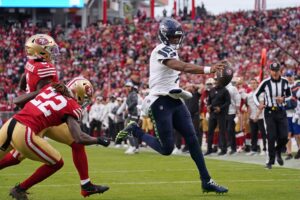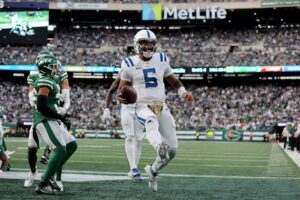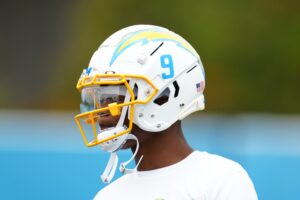He’s one of the hottest coordinators in recent memory – an offensive architect who designed the evolution of Matt Ryan from a league average quarterback to the MVP favorite. He conceived one of the most potent scoring offenses in NFL history, an offense that Sunday torched Green Bay for 44 points in route to a Super Bowl. He’s set to be Chip Kelly’s successor in San Francisco. But who really is Kyle Shanahan?
Who Exactly is Kyle Shanahan?
Texas and Jon Gruden
Many reiterate that Kyle is the son of Mike Shanahan, the two-time Super Bowl winning coach in Denver. Kyle played wide receiver at the University of Texas, catching passes from Major Applewhite and Chris Simms. He made his way to the NFL one year removed from his graduation in 2003 – as a coach. At 24 years old, Shanahan worked under Jon Gruden in Tampa Bay as an assistant coach for offensive quality control. Much of his passing acumen and quarterback knowledge is thought to be derived from Gruden. Troy Aikman said during Sunday’s broadcast about Kyle, “He wanted to have a running game like Mike Shanahan had over the years with the Denver Broncos. But he learned a lot of his philosophy and offense from Jon Gruden.”
The Youngest at Every Level
Shanahan worked two seasons under Gruden. Gary Kubiak hired him in 2006 to be a wide receivers coach for the Houston Texans. This make Kyle the youngest position coach in the NFL at 26 years old. By the next season, he was already moving up the ranks, and was named the quarterbacks coach in Houston. That season QBs Matt Schaub (4-7 on the season) and Sage Rosenfels (4-1 on the season) combined to win eight games for the Texans. Rosenfels would go on to start five more games for Houston in 2008, then never see another snap of live action in his career.
In 2008, Kyle Shanahan received another promotion in Houston. This time he was becoming the youngest offensive coordinator in the league by over three years. In two seasons as the offensive coordinator, Shanahan’s offenses finished ninth in DVOA in 2008, and sixth in 2009. This was yet again with the quarterback duo of Schaub and Rosenfels, and before the breakout season from Arian Foster in 2010. That was Kyle Shanahan a for the first four years as an NFL coach. Making a modicum of something out of nothing.
Like Father, Like Son
Kyle Shanahan left Houston after the 2009 season to join his father in Washington, taking on the same offensive coordinator position. The first two seasons of Kyle Shanahan in Washington were rather uneventful. 2010 capped the final year in Donovan McNabb‘s career, coupled with the, “oh not him again,” return of former Bears castaway Rex Grossman. The 2011 season witnessed Shanahan starting not only Grossman, but also 31 year old Jon Beck (wait, who?). Beck had previously made only four career NFL starts back in 2007. These two seasons saw the Washington offense finish an unsurprising 26th and 18th in offensive DVOA.
The next era in Washington was interesting for Shanahan. After drafting Robert Griffin III with the second pick in 2012, Shanahan implamented a college style offense similar to the one Griffin ran at Baylor. Great coaches have a style, and constantly retool and rebuild their style to fit their personnel. Like Mike Krzyzewski adopting a zone defense late in his career or Coach Taylor redesigning his pro-style offense to a wildcat system to fit QB Vince Howard in Friday Night Lights, Shanahan reworked his playbook to fit RGIII‘s strengths. In the words of Kyle himself, “People talk about players fitting a system—that’s overrated. Good players fit everyone’s system, a good player will fit your system. Julio fits any system.” You think?
Anyone have the number for missing persons? I want to file a report for Ladarius Gunter. Last seen trying to cover Julio Jones. pic.twitter.com/imSvfNpzyA
— Sam Monson (@PFF_Sam) January 22, 2017
Unsurprisingly, Kyle believes that building this offense from scratch actually helped make him an even better coach. “It challenged me, because I had to do some things that I hadn’t done before, so I had to look at tape in a different way and try to put some different things in,” Shanahan said. “And I think that improved myself. I’m able to see the game a little differently.” This college scheme with zone-read elements led RGIII to one of the most electrifying rookie campaigns of all time. He finished his rookie campaign with 27 total touchdowns while throwing only five interceptions, and a quarterback rating of 102.4.
The Washington Fallout
Things quickly fell apart for the Shanahans in Washington after 2012. A multitude of injuries to Griffin’s knees had people questioning Kyle Shanahan’s play calling. Why set up a fragile quarterback to take so many hits? Ironically, all three of Griffin’s major injuries came on passing plays – not designed runs. Shanahan spoke on the zone-read calls, saying “…not many big hits happened on that. Usually everyone is blocked for. You know who isn’t blocked. Look at the big hits. Look at what plays they were. The three injuries were pass plays.” Fallout between the style of play and results following his rookie season would lead to a discord that would drive the Shanahan’s out of Washington.
In 2014, Kyle Shanahan was hired to be the offensive coordinator of the Cleveland Browns. After being one of the hottest coaching candidates in the league following the remarkable 2012 season with RGIII, Shanahan was simply looking for work. Similarly to his teams in Houston and early in his Redskins tenure, Shanahan was yet again working with a hodgepodge of quarterbacks. Three different players made a start at quarterback for the Browns in 2014 – Brian Hoyer, Johnny Manziel, and Connor Shaw. After feeling pushed to start Manziel and seeming dysfunction in the front office (Surprise! It’s the Browns!), Shanahan walked away from the job after just one season. In what now looks like a classic Browns move, the Cleveland Browns just let him walk.
The Ascent
“The genes weren’t working for me when I was trying to be a player,” said Shanahan. “They worked a little bit better for me as a coach.” Fittingly, this year when describing the intricacies of the Atlanta offense, Shanahan said, “I know it inside and out, but I’d have no chance doing it.” As brilliant as Shanahan’s schemes may be, he still needs a quarterback capable of executing the offense. He was severely lacking this in many of his early coordinator gigs. Atlanta brought him consistency in the form of Matt Ryan.
Last year was Kyle Shanahan’s first year in Atlanta. That season Matt Ryan threw only 21 touchdowns to 16 interceptions. This season, ‘Matty Ice’ will likely take home the MVP award. He’s thrown 38 touchdowns to only seven interceptions. Strikingly, Ryan threw for 353 more yards on 80 less attempts than he did in 2015. Few people saw this kind of jump by Ryan and the Atlanta offense coming. Ryan did. Mic’d up on the sidelines during a game early in 2015, Ryan sat down next to Kyle, frustrated. “I can’t wait until I know the offense inside and out though bro, because we are going to kill people with it.”
Week 1 de la saison 2015-2016.
Matt Ryan savait que l’attaque de Kyle Shanahan allait être exceptionnelle #RiseUp pic.twitter.com/L3sMsidURs— NFL France (@FirstDownFR) January 23, 2017
He wasn’t wrong. The scheme envisioned by Shanahan and implemented by Ryan produced an offense that scored 33.8 points per game in the regular season. This tied them with the 2000 Rams’ ‘Greatest Show on Turf’ offense as the seventh best scoring offense in NFL history. Ironically, this was the same offense that Bill Belichick shut down – they scored only 17 points – en route to his first Lombardi trophy.
“He learned a lot from the Washington and Cleveland experiences,” said one executive from a rival of Atlanta’s. “He’s got a good mind for putting players in positions to succeed and using them to their strengths.” Assuming Kyle Shanahan takes the job in San Francisco, he certainly has an uphill battle ahead of him. He inherits a roster devoid of much talent and without a franchise quarterback. Regardless, in San Francisco he has assets, a clean slate, and the same brilliant football mind that got him here.






